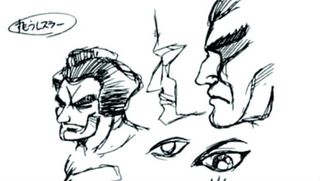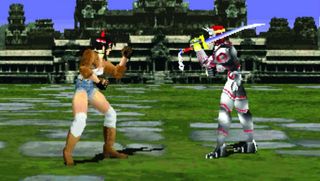The Making Of... Tekken

Katsuhiro Harada took an odd route into development. While reading psychology at Waseda university, he decided he wanted to work with the arcade games he’d spent his youth sneaking out of school to play. He weighed up his options – a studio, an events company, a specialist magazine – but he had no experience and no transferable skills. He saw a vacancy for a sales rep at an arcade, figured a knowledge of the ways of the human brain would be useful, and applied for it. Then for another job and another, firing off CVs to every big videogame company of the time.
“I applied to Namco, Sega, Capcom, Taito, Square and many others,” he tells us. But he was busy with student life, and in no mood to wait. “I was studying; I was busy with my yacht racing society. I didn’t think I really wanted a job with Namco, but they were the first company to offer me a job. I accepted it.”
He would go on to break Namco’s record for first-year arcade sales, earning him sufficient kudos to press higher-ups for a move into game development. Twenty years later, he’s still there, now overseeing a series that, back in 1994, was just an idea. At that time, Capcom’s Street Fighter II series ruled the 2D fighting game genre and Sega had got to market early with the polygonal 3D Virtua Fighter. Namco wanted to make the game to beat Sega, and was already pulling ahead from its rivals in its understanding of high-poly technology, but its development staff were still finding their feet in the transition from 2D. Having the tech was one thing; knowing how to use it to make games was another matter entirely. The solution was, in a way, obvious.
“Some staff joined us from Sega who had worked on Virtua Fighter,” Harada says. “They were mainly animators, and some programmers. Then we had a team at Namco that had made Knuckle Heads, this really boring 2D Namco fighting game, and a planning team too.” They set to work, but they weren’t really making a fighting game at first. “The most important part of a fighting game is how the characters move. It was an animation experiment. We knew 3D human body movement would be critical for the next 20 or 30 years of games. The creation of Tekken was not only about making a new game – we were also researching the future.”

It was a research project with the steepest of learning curves. These were problems that simply didn’t exist in 2D games, where realism was a peripheral concern. When you throw a punch with one arm, your other arm moves as well to keep your balance, something games played from a side-on view never had to show. And in Street Fighter II, every character gets hit from the front or the back, never from the side. What happens when a fighter connects with a right hook in a 3D space at 60 frames per second? “2D fighting games are like a flip book, every frame designed one by one. They are like pictures that we watch from a side-on view, but the 3D fighting game has space. It wasn’t just about the coolness of the animation, but how we could actually make the character hit the opponent. That was the tough part.”
It was a factor in the decision to eschew Street Fighter’s fantastical moves and base Tekken on more realistic punches and kicks. That was a product of the time, too: with the move to 3D games, developers and players were leaning more towards the realistic. “When people saw 3D, they thought the era of virtual reality had finally come,” Harada says. “So we thought everyone wanted something more realistic. Polygons look real, with smooth movement, so we thought, ‘Let’s create Chinese kenpo,’ or, ‘Let’s replicate the real skill of judo.’ It wasn’t like we all thought, ‘Let’s differentiate ourselves from Street Fighter.’ It was about recreating something that actually exists in the real world.”
Yet even that proved complex. With eight characters in production for the arcade version, each with their own fighting style, the work piled up. There were a couple of hundred animations per character – nothing by modern standards, of course, but it was simply too much for a team moving from sprite-based 2D. Namco started hiring, assigning multiple staff to each character. By the time the project was complete, the team had grown from around 20 to almost 50.
Sign up to the GamesRadar+ Newsletter
Weekly digests, tales from the communities you love, and more
Twenty years later, Harada is still coy about the designs of the characters themselves – no surprise given how many of them seem to be based on famous stars and films. He admits Paul, the hard-hitting biker with the impossibly tall blond flattop, was inspired by a character of the same name in the manga JoJo’s Bizarre Adventure. Masamichi Abe, now at Nintendo but back then a member of the Tekken planning team, was a fan. Others were more obvious; Harada has never publicly admitted the inspiration for bare-chested kung fu fighter Marshall Law, though there’s a subtle admission of Bruce Lee’s influence to be found on Law’s alternate costume. On the back, the number three is written in blue. Blue Three: Bruce Lee.

Harada regrets this approach, since different people drawing inspiration from different places meant there was no consistent style across the cast. “I’d redo the character designs,” Harada says when we ask what he’d change in retrospect. “They may have been unique, but they didn’t really have any meaning. In Virtua Fighter, costumes were always the same, so people would see a character and know who they were immediately. Street Fighter was the same. Tekken was a bit half-hearted in that area. Look at Michelle: she’s just wearing a white shirt and black trousers, but in [her alternate costume] she looks like a Native American. There was no concept there. It lacks consistency.”
The final game lacked balance, too. “We did almost no balancing,” Harada says. “Back then, developers just went by how things felt. They did it manually, not with a calculator. It was only around the middle of developmenton Tekken 2 that we starting using numerical conversion and calculation.” There were infinite combos – Jack could use his Cossack Dance to kick away an entire health bar with his stubby little legs – and one-shot kills. “We just used our senses; there was no theory at the time. In that sense, Tekken 1 isn’t really a fighting game. It should be called a human body action game. They have abilities, and they hit each other, but it’s not really a martial arts game.”
Perhaps that lack of balance explains why Tekken failed to take off in Japanese arcades; it sold well enough, but few placed two cabinets back to back, as was then – and remains – customary for versus fighting games. In single-cab form, it was positioned as a technical showcase of Namco’s 3D prowess, but players didn’t take it too seriously. Thankfully, Tekken would fare much better when, three months after launch, it made its way from the arcade to store shelves.
Tekken was a perfect fit for PlayStation, and not only because its four-button control system – one for each limb – was a perfect fit for the console’s controller. It was also a generational leap forward for one of gaming’s most popular genres on new hardware as early adopters were crying out for technical showcases. Now, for the first time, home consoles could offer the same level of graphical fidelity as the arcade. PlayStation Tekken was almost arcade perfect.

But not quite. While the move to CD-ROM gave console developers more space, 650MB still wasn’t quite enough for Namco. On the arcade version, when a fighter was chosen on the character-select screen, an animation would play; that was cut from the home version. The console version’s animation data was compressed to about 70 per cent of that of the arcade edition. It would become more severe as time progressed – by Tekken 3, it was down to ten per cent.
Harada speaks of a generational split among the Tekken team, with an old guard used to working in 2D to strict hardware limitations, and what Harada calls the Polygon Generation – 20-somethings who had cut their teeth on roomier, more powerful systems. “They would say to us, ‘We’re jealous! You have 2MB of memory! In our day, we only had a few kilobytes. You can do anything with 2MB.’” That old guard, however, knew all about data compression. They tinkered endlessly, not only with the size of the data but where it was placed on the disc. Data on the outer portion of a CD is read faster than data towards the centre, and that realisation meant that Tekken, despite being one of the most complex PS1 games of the time, had the fastest load times around. And it was all thanks to the old hands. “Masanori Yamada was in charge of it,” Harada says. “He’s still with Namco, and in a senior position. We called him a genius.”
Tekken reviewed well around the world, and had the sales to match, with more than a million units sold worldwide. The game performed better in Europe than in any other territory, a trend that continued for 20 years. To date, series sales stand at a shade over 43 million units – more than half of them European. Harada believes that Sony publishing the game in the territory was key, lending it a level of brand kudos it would not have enjoyed with Namco’s name on the box.
Tekken 2 would arrive in Japanese arcades just five months after Tekken released for PlayStation in the territory. Harada provided the voices for Yoshimitsu and Marshall Law, and worked on Kuma’s animation. By the time Tekken 4 rolled around, Harada had risen to the role of director. He had fallen into game development almost by accident, but now Tekken is his life’s work. Even today, he seems surprised that he has devoted his entire career to a single series.

“In the game industry, technology develops so rapidly, doesn’t it? Trends come and go, [and] I was sceptical about whether one title could last so long, make money for so long. When you look back in history, there have been so many fighting games, especially in the ’90s. But how many remain now? Very few. Games would release and fade away. I never thought it would last this long. Nobody did.”
Least of all his parents, who found themselves utterly devastated by their son’s chosen profession. “They were both civil servants – they served their country,” Harada explains. “I have two older sisters, but I was the only boy, so they had high expectations of me. They wanted me to work for a bank or trading company – you know, be a so-called ‘salaryman’. This work is something my parents could not understand. There was no such occupation when they were kids, and they kept telling me they were worried about my future.”
They needn’t have worried, of course, but Harada was so conscious of their disdain for his work that he couldn’t quite tell them the truth. We’ve all kept the odd secret from our elders, but Harada managed to hide his true job from his parents for a decade, his cover only blown when they saw him on the cover of a magazine promoting Tekken 5.
“Tekken was so violent,” he says. “I was raised in a strict family. I studied a lot, took sport seriously, didn’t get into fights... So I told them I was working on something else. First I told them I was making Prop Cycle. Later it was Taiko No Tatsujin. I think it came out four or five years after I joined Namco. My junior staff made that game!”
Twenty years ago,Tekken was just an idea. Eventually, Namco’s unbalanced, inconsistent animation research project helped put PlayStations in homes across the world. In Japan, making one’s hobby a job has long been frowned upon. But few people – even his parents – can now dispute that Harada’s has been time well spent.
Edge magazine was launched in 1993 with a mission to dig deep into the inner workings of the international videogame industry, quickly building a reputation for next-level analysis, features, interviews and reviews that holds fast nearly 30 years on.

Diablo 4 lead says "obvious" bad ideas used to "fall through the cracks" because the devs didn't fully realize "doing this 2,000 times is actually terrible"

Final Fantasy 3's programmer is so legendary that people are starting to think it took 16 years to bring back the JRPG because nobody else could replicate his code
Most Popular





